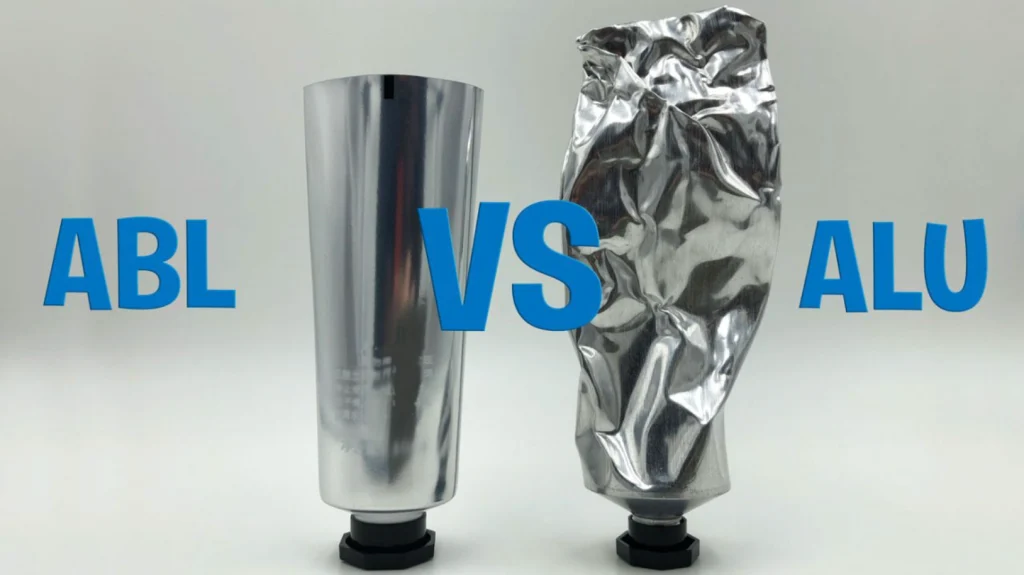Introduction of Collapsible Tube in Cosmetic Industry
In today’s eco-conscious world, brands are continuously exploring collapsible tube packaging solutions that not only preserve the quality of their products but also align with sustainable practices. The cosmetic industry, in particular, has been at the forefront of this shift, navigating through various packaging options to find the perfect fit. Among the array of choices, Aluminium Collapsible Tubes and Aluminium Barrier Laminate (ABL) tubes stand out for their distinctive properties and benefits.
In conversations with various clients, we have observed that numerous customers often encounter difficulties selecting these two tubes. This article delves into the nuances of these two popular choices, shedding light on why they’re considered superior packaging alternatives, especially for cosmetics.
Difference
Different Production Procedures of Aluminum Collapsible Tube and Laminated Tube
One of the major differences between these tubes lies in their manufacturing process. While aluminium tubes are formed from a single aluminum flug, offering a seamless tube, ABL tubes are created by welding a flat sheet into a cylindrical form, resulting in a visible seam along the side.
Aluminium tubes have long been heralded for their durability and protective qualities. Crafted entirely from pure aluminium, these tubes offer a high barrier against air, moisture, and light, significantly extending the shelf life of products. Their sturdy nature prevents damage during transportation, ensuring the product remains intact. On the other hand, Aluminium Barrier Laminate tubes, or ABL tubes, represent a modern innovation in packaging. Comprising an aluminium barrier sandwiched between layers of polyethylene, ABL tubes offer the resilience of aluminium with the flexibility and aesthetic appeal of plastic.
The below information regarding the advantages and disadvantages of the different collapsible tube serves as a helpful resource for those wondering which type of tube best aligns with their product needs.
Advantages of Aluminum Collapsible Tube
- High Barrier Protection: Aluminum offers excellent barrier properties against air, moisture, and contamination, making these tubes perfect for sensitive products like pharmaceuticals and foods.
- Durability: These tubes are highly resistant to puncture or damage during shipping and handling.
- Sustainability: Aluminum tubes are recyclable, contributing to environmental sustainability.
- Temperature Resistance: They can withstand high and low temperatures without affecting the contents.
- Non-reactivity: Aluminum does not react with the contents, ensuring the product’s integrity over time.
Disadvantages of Aluminum Collapsible Tube
- Cost: Aluminum tubes can be more expensive due to the material and manufacturing processes involved.
- Limited Flexibility: Once squeezed, they do not return to their original shape, which can be less appealing for some users.
- Denting: Although durable, they can dent upon impact, affecting aesthetics.
Advantages of ABL (Aluminum Barrier Laminate) Tube
- Combination of Barrier Protection: ABL tubes combine the barrier properties of aluminum with the flexibility and feel of plastic, offering a versatile packaging solution.
- Aesthetic Flexibility: These tubes can be printed with high-quality graphics, making them an excellent option for cosmetic and personal care products.
- Resilience: They are less prone to denting and retain shape better than pure aluminum tubes.
- Eco-friendly: ABL tubes are often seen as more environmentally friendly due to their composite nature, which can reduce the use of pure aluminum.
- Cost-Effective: They tend to be more affordable than pure aluminum tubes, providing a cost-effective barrier solution.
Disadvantages of ABL (Aluminum Barrier Laminate) Tube
- Barrier Efficiency: While offering good protection, the barrier properties might not be as supreme as pure aluminum tubes, particularly for very sensitive products.
- Recycling Complexity: The multi-layer structure can make recycling more complex than single-material tubes.
- Perception: For some high-end or traditional products, the feel of ABL might not match the premium quality impression that pure aluminum tubes provide.
Both aluminum collapsible tubes and ABL tubes offer unique benefits tailored to different product needs and industries. The choice between them often depends on factors like the level of barrier protection required, sustainability considerations, cost constraints, and aesthetic preferences.


